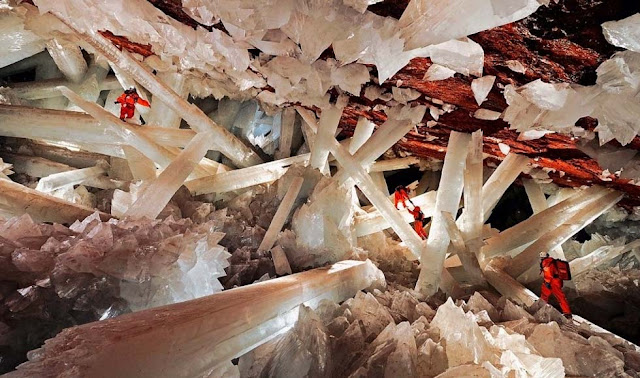Naica’s crystal caves maintain lengthy-dormant life
 |
| The caves have been found by miners one hundred years in the past |
It is a exceptional discovery in a tremendous place.
Scientists have extracted lengthy-dormant microbes from contained in the well-known big crystals of the Naica mountain caves in Mexico – and revived them.
In a Mexican cave system so lovely and scorching that it’s referred to as each Fairyland and hell, scientists have found life trapped in crystals that could possibly be 50,000 years previous.
The weird and historic microbes have been discovered dormant in caves in Naica, Mexico, and have been capable of exist by dwelling on minerals corresponding to iron and manganese, stated Penelope Boston, head of NASA’s Astrobiology Institute.
“It’s tremendous life,” stated Boston, who introduced the invention Friday on the American Association for the Advancement of Science convention in Boston.
If confirmed, the discover is yet one more instance of how microbes can survive in extraordinarily punishing circumstances on Earth.
Though it was introduced at a science convention and was the results of 9 years of labor, the findings have not but been revealed in a scientific journal and have not been peer reviewed. Boston deliberate extra genetic exams for the microbes she revived each within the lab and on website.
The life types—forty totally different strains of microbes and even some viruses—are so bizarre that their nearest kinfolk are nonetheless 10 % totally different genetically. That makes their closest relative nonetheless fairly distant, about as distant as people are from mushrooms, Boston stated.
The Naica caves—an deserted lead and zinc mine—are half a mile (800 meters) deep. Before drilling occurred by a mine firm, the mines had been utterly minimize off from the surface world. Some have been as huge as cathedrals, with crystals lining the iron partitions.
They have been additionally so scorching that scientists needed to don low cost variations of area fits—to stop contamination with outdoors life—and had ice packs throughout their our bodies.
Boston stated the workforce might solely work about 20 minutes at a time earlier than ducking to a “cool” room that was about one hundred levels (38 Celsius).
NASA would not permit Boston to share her work for outdoor evaluate earlier than Friday’s announcement so scientists could not say a lot. But University of South Florida biologist Norine Noonan, who wasn’t a part of the research however was on a panel the place Boston introduced her work, stated it made sense.
“Why are we stunned?” Noonan stated. “As a biologist I would say life on Earth is extraordinarily robust and very versatile.”
This is not the oldest excessive life. Several years in the past, a special group of scientists revealed research about microbes that could be half one million years previous and nonetheless alive. Those have been trapped in ice and salt, which is not fairly the identical as rock or crystal, Boston stated.
The age of the Naica microbes was decided by outdoors specialists who checked out the place the microbes have been situated within the crystals and how briskly these crystals develop.
It’s not the one bizarre life Boston is analyzing. She can also be learning microbes generally present in caves in america, Ukraine and elsewhere that eat copper sulfate and appear to be near indestructible.
“It’s merely one other illustration of simply how utterly robust Earth life is,” Boston stated.
© The Associated Press.